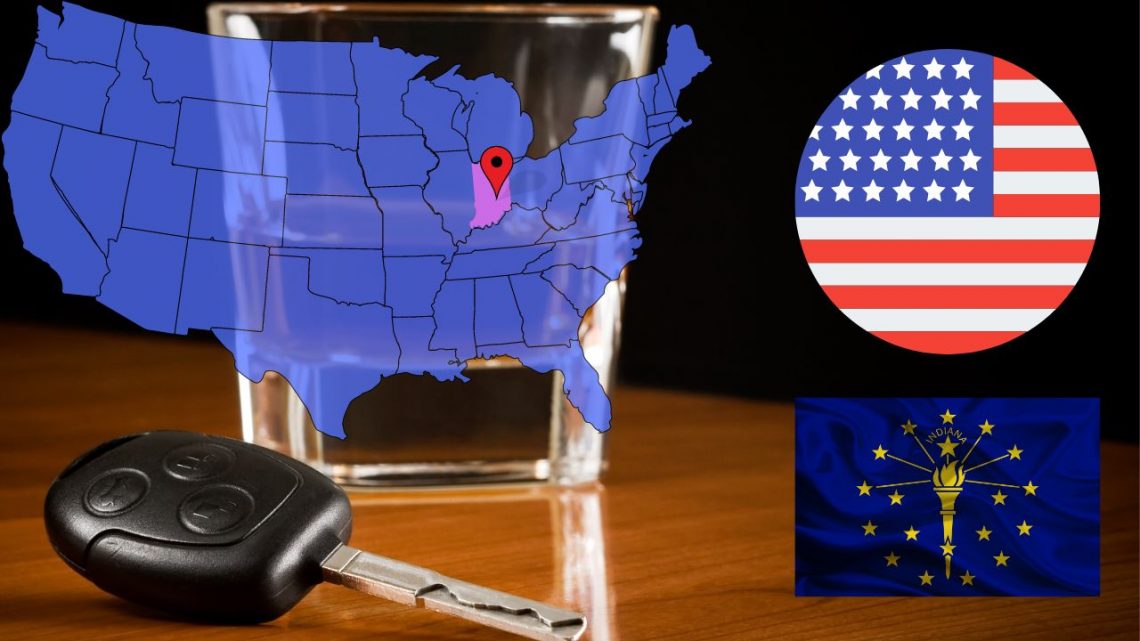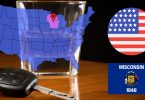In Indiana, the permissible blood alcohol concentration (BAC) is capped at 0.08%, equivalent to 80 milligrams of alcohol per 100 milliliters of blood.
Keep in mind that the primary objective of this post is to educate readers on Indiana drunk driving laws. This page is not meant to promote drunk driving or to advertise it.
What is the legal alcohol limit for driving in Indiana?
In Indiana, the legal alcohol limit for driving varies depending on the driver’s category. Recognizing the importance of road safety, Indiana law sets specific blood alcohol concentration (BAC) limits for different groups of drivers to minimize the risks associated with impaired driving. Below are the defined legal limits:
- Regular Drivers: The legal BAC limit is 0.08%. This applies to the majority of drivers operating personal vehicles.
- Commercial Drivers: For those holding a commercial driver’s license (CDL), the legal limit is more stringent, set at 0.04%, reflecting the higher responsibility associated with operating commercial vehicles.
- Minors (Under 21): Indiana enforces a zero-tolerance policy for underage drinking and driving. It is illegal for minors to drive with any detectable amount of alcohol in their system, aiming to discourage alcohol consumption among young drivers and enhance road safety.
Drink and Drive Penalties and Punishments in Indiana
Driving under the influence (DUI) or operating a vehicle while intoxicated (OWI) in Indiana carries severe penalties, reflecting the state’s commitment to road safety and zero tolerance for impaired driving. It’s crucial for drivers to understand the consequences of DUI or OWI offenses, as well as to frequently consult the official state website for the most current information, as laws and penalties may change.
If You Are Arrested for Operating a Motor Vehicle While Intoxicated:
- Immediate Consequences: You will be handcuffed, taken to the police station, and your car and person will be searched. Your vehicle will be towed at your expense.
- Breath Test: You’ll be asked to take a certified breath test. Refusing this test triggers an automatic one-year license suspension due to Indiana’s implied consent law (IC 9-30-6-1).
- Breath Test Failure: A breath test result of .08% BAC or higher leads to a minimum 30-day driver’s license suspension.
- Bail: To be released from jail, bail must be posted.
If You Are Convicted of Operating a Motor Vehicle While Intoxicated:
-
First Offense:
- Court costs and fees exceeding $300.
- Possible jail sentence up to one year.
- Fines up to $5,000.
- License suspension up to two years, or probation with a substance abuse course requirement. A minimum 30-day suspension followed by a 180-day probationary period for employment-related driving only.
- Possible attendance at a victim impact panel and urine testing for drugs and alcohol.
- Other probation terms may apply.
-
Second Offense:
- Imprisonment for five days to three years, and/or community service.
- Fines up to $10,000.
- License suspension from 180 days to two years.
- Additional probation terms similar to the first offense.
-
Third Offense:
- Imprisonment from 10 days to three years, and/or community service.
- Fines up to $10,000.
- License suspension from one year to 10 years, with possible habitual traffic violator status.
- Possible additional imprisonment as a habitual substance offender.
- Similar probation terms to the first offense.
Ignition Interlock Device (IID):
- Conviction for OWI or DUI may require an IID installation in your vehicle. After a prior conviction within the last ten years, installation is mandatory unless an alcohol treatment program is completed.
Drivers Under the Age of 21:
- For BAC levels of 0.02% to less than 0.08%, there’s a one-year license suspension and a $500 fine.
- DUI offenses with a BAC of 0.08% or higher are subject to the same penalties as adults.
These penalties highlight the importance of adhering to Indiana’s DUI/OWI laws to ensure the safety of all road users. Remember, legal advice and the latest legal information can be obtained from the official state website or through consultation with a legal professional.
How Can I Calculate if My Alcohol Blood Limit is Legal in Indiana?
In Indiana, as in other states, law enforcement uses breathalyzer tests at the roadside to determine a driver’s blood alcohol concentration (BAC). These tests are designed to measure the amount of alcohol in your breath, which is then converted into a BAC percentage. This method is widely accepted and utilized due to its non-invasiveness and immediacy of results. Understanding your BAC level is crucial, as driving with a BAC of 0.08% or higher is illegal for most drivers, with even stricter limits for commercial drivers and minors.
To assist you in ensuring your BAC levels remain within legal limits, here are two methods I recommend, drawing from my decade of experience as a phlebotomist:
- Use a High-Quality Alcohol Breathalyzer: For those seeking a reliable way to measure their BAC, I highly recommend the BACtrack S80. This device is renowned for its professional-grade accuracy and is both DOT & NHTSA approved, as well as FDA 510(k) cleared. Its precision makes it a valuable tool for anyone who wants to ensure they’re within legal limits before driving. Keeping a BACtrack S80 in your vehicle can be a prudent measure, especially since it’s common for individuals to misjudge their level of impairment. The device’s ease of use and fast, accurate readings can provide peace of mind or serve as a crucial warning against driving when you shouldn’t.
- My BAC Calculator: In collaboration with fellow phlebotomists and web developers, I’ve created an online BAC calculator. This tool is designed to estimate your BAC based on the quantity and type of alcohol consumed, your weight, and the time frame over which you’ve been drinking. While this calculator can offer a useful estimate, it’s important to remember that numerous factors affect BAC and its impact on your ability to drive safely.
It’s essential to note that while both of these methods can provide valuable insights into your BAC level, they do not guarantee 100% accuracy. Factors such as metabolism, food intake, and individual health can influence your actual BAC and how alcohol affects your driving abilities. Therefore, these tools should be used as guides to help you make safer decisions but not as definitive indicators of your legality to drive.
Remember, the safest approach is always to avoid driving if you’ve consumed alcohol or if there’s any doubt about your sobriety. This precaution not only ensures your safety but also that of others on the road.
Ways to Avoid Driving with a High BAC in Indiana

Driving with a high blood alcohol concentration (BAC) not only endangers your life but also the lives of others on the road. Fortunately, there are several safe and convenient alternatives to driving under the influence in Indiana. Here are some effective strategies to ensure you and others remain safe:
- Utilize Rideshare and Taxi Services: One of the simplest ways to avoid the risks associated with drunk driving is to use rideshare apps like Uber or Lyft. These apps offer a convenient and reliable way to get home safely at any hour. For those who prefer traditional taxi services, local companies provide excellent alternatives. In Indianapolis, consider using Indianapolis Taxi Service for a reliable ride. In Fort Wayne, Ben’s Economy Taxi, LLC offers trustworthy service to get you home safely. These services are readily available and can be easily accessed through a phone call or their respective apps.
- Order a Designated Driver Service: If you’ve driven to a location and find yourself unable to safely drive your vehicle back due to alcohol consumption, a designated driver service is an excellent solution. These services provide a driver to safely drive you and your car home. In Indianapolis, Pride Executive Car Service is a reputable choice. For those in Fort Wayne, H&D Transportation Service, LLC offers similar services. To find a designated driver service in your area, a quick online search for “designated driver service” along with your city name will provide you with options.
Both of these methods not only help in avoiding the legal consequences of driving with a high BAC but more importantly, they play a crucial role in preventing accidents and saving lives. Planning ahead and knowing your options can make all the difference. Whether it’s bookmarking a rideshare app, saving the number of a local taxi service, or being aware of designated driver services in your area, taking these steps ensures that you have a safe plan to get home without putting yourself or others at risk. Remember, safety should always be your top priority when it comes to alcohol and driving.
Sticking to DUI Laws in Indiana: Sad Statistics
In Indiana, it’s illegal to drive while intoxicated. In 2020, the state saw 897 fatal accidents involving alcohol, with 249 cases involving drivers with a BAC over 0.08%. Indiana’s DUI laws aim to reduce drunk driving, emphasizing the importance of staying below the legal BAC limit.
Before considering driving after consuming alcohol, explore alternatives like taxis or designated driver services. It’s crucial to stay informed about DUI regulations by visiting the official state website. Drunk driving poses significant risks; the safest approach is to avoid driving after drinking. If driving is unavoidable, ensure your BAC is within legal limits, using a reliable breathalyzer for accuracy. Regularly reviewing Indiana’s DUI laws online is also advisable.







